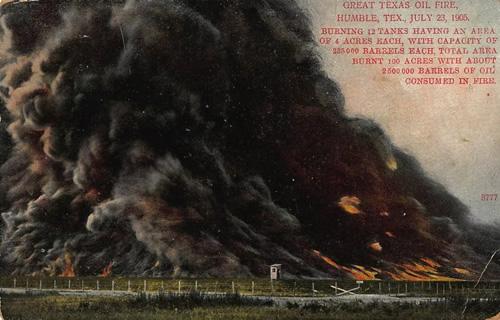|
Whenever
anyone asked Charlie Hudson what brought him to Haskell
County, the Mississippi native had quite a story to tell.
The short answer would be horse and mule work, but that doesn't do
the tale justice.
Hudson came to Texas with his family in 1886 at the age of 16. They
settled in Hill County,
where in 1893 he married an Alabama girl. The young couple saved their
money so that Hudson could go into business for himself as a dirt-mover.
Finally he had enough cash to buy a span of horses, a dirt-moving
slip and a good wagon.
At first he contracted to build railroad right of way, adding more
teams and equipment as his business grew. When Texas entered the oil
era with the Spindletop
discovery in 1901 near Beaumont,
Hudson made good money building earthen storage tanks for the hundreds
of thousands of gallons of black gold gushing from wells in Southeast
Texas.
Late in 1904, wildcatters searching for new pools found oil around
the small community of Humble
in Harris County.
By early 1905, the field had spawned yet another boom. Again, Hudson
found plenty of work using his horse and mule teams to excavate and
raise berms to accommodate all the oil shooting to the surface in
the hot new field.
Hudson's enthusiasm for the oil business changed abruptly on July
23, 1905. That evening, a thunderstorm triggered a bolt of lightning
that ignited the oil in one of the large tanks Hudson had helped build.
Sending billows of thick, black smoke high in the sky, the fire spread
quickly. |
 |
The inferno
incinerated men and mules and equipment. Before the fire died out
for lack of fuel, it had consumed some 900,000 gallons of crude.
After the fire, Hudson figured he had been in the oil business long
enough. He returned to Hill
County, but in early October decided to take up farming in West
Texas. With his wife and three children, Hudson set out in a covered
wagon for Haskell County.
And that's where he stayed for the rest of his long life.
But
Hudson never forgot that fiery night in 1905, later recollecting that
40 men and 160 mules had perished in the Humble disaster that transformed
him into a West Texan.
The exact death count may never be known. Newspaper of the day accounts
had the number of casualties ranging from a hard-to-believe solitary
death to 40 or 50 fatalities. The day after the fire, the Houston
Chronicle reported 15 deaths, but the stories said that the heat of
the fire had reduced man and animal to piles of ashes, preventing
an accurate assessment of the death toll.
The Jim Crow racism of the day also played a role in the inexact accounting.
The Chronicle reported that only one of the victims, a watchman named
"Slim" was white. The others were black.
Another reason for the lack of clarity on the effects of the disaster
is that the fire occurred before the oil industry had any regulation
to speak of. The Texas Railroad Commission, created in 1892 to oversee
railroad rates in the state, had no authority yet over the nascent
petroleum industry. (It would come, but much later.) The concept of
federal industrial safety regulation was not even a gleam in a liberal
Congressman's eye, the creation of OSHA not coming until 1969.
Since the fire clearly had been the result of an act of nature, no
authority investigated whether the storage facilities had been safely
constructed and no entity held hearings or compiled an official report.
The Humble field played soon out, and the surviving men and mules
moved to the next paying field, a process that would continue in the
state well into the 1930s. By then, of course, heavy machinery had
pretty much replaced the need for mules though some oil companies
used them until the 1950s.
A couple of years after the fire, a man named Frank Rilling, probably
an oilfield worker, sent a penny postcard showing the towering black
smoke from the Humble fire to his girlfriend in Bridgeport, Conn.
"Received your pretty postal [post card] with many thanks," he wrote.
"I am in a hurry answering, am I not[?]" Then Rilling scribbled beneath
the image: "This was a grand thing to see as it burned at night."
Of course, it hadn't been grand for the family and friends of the
men lost, not to mention all the mules. But that fire got Charlie
Hudson and his family to Haskell
County. |
|
|
